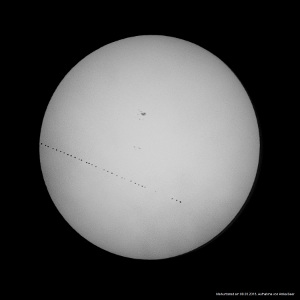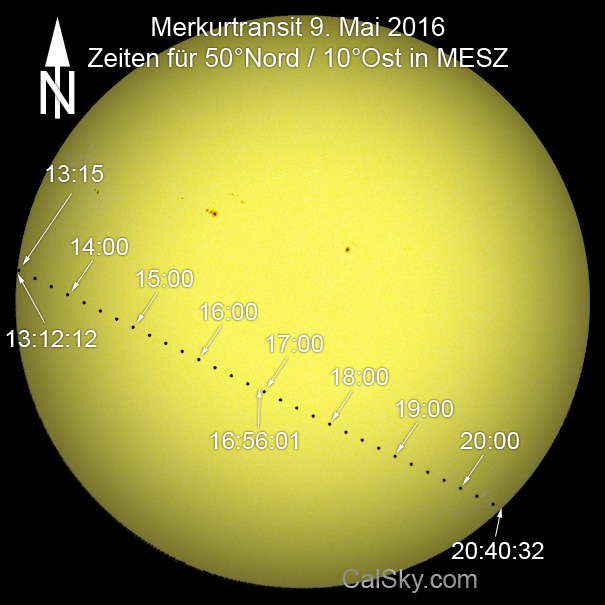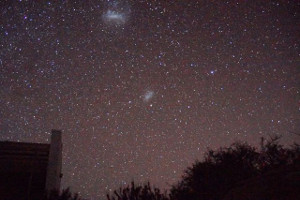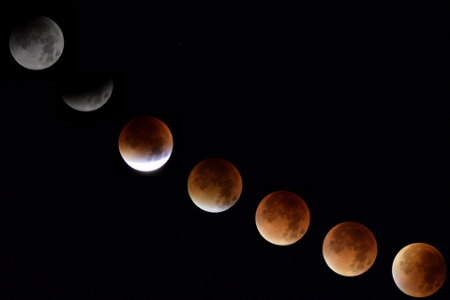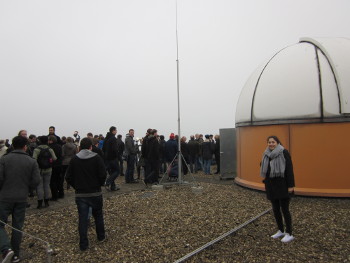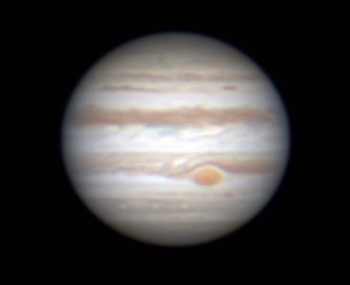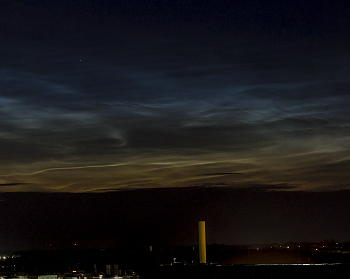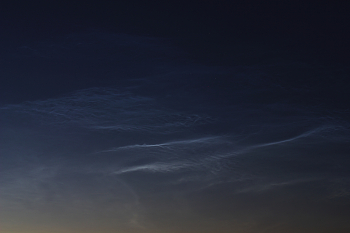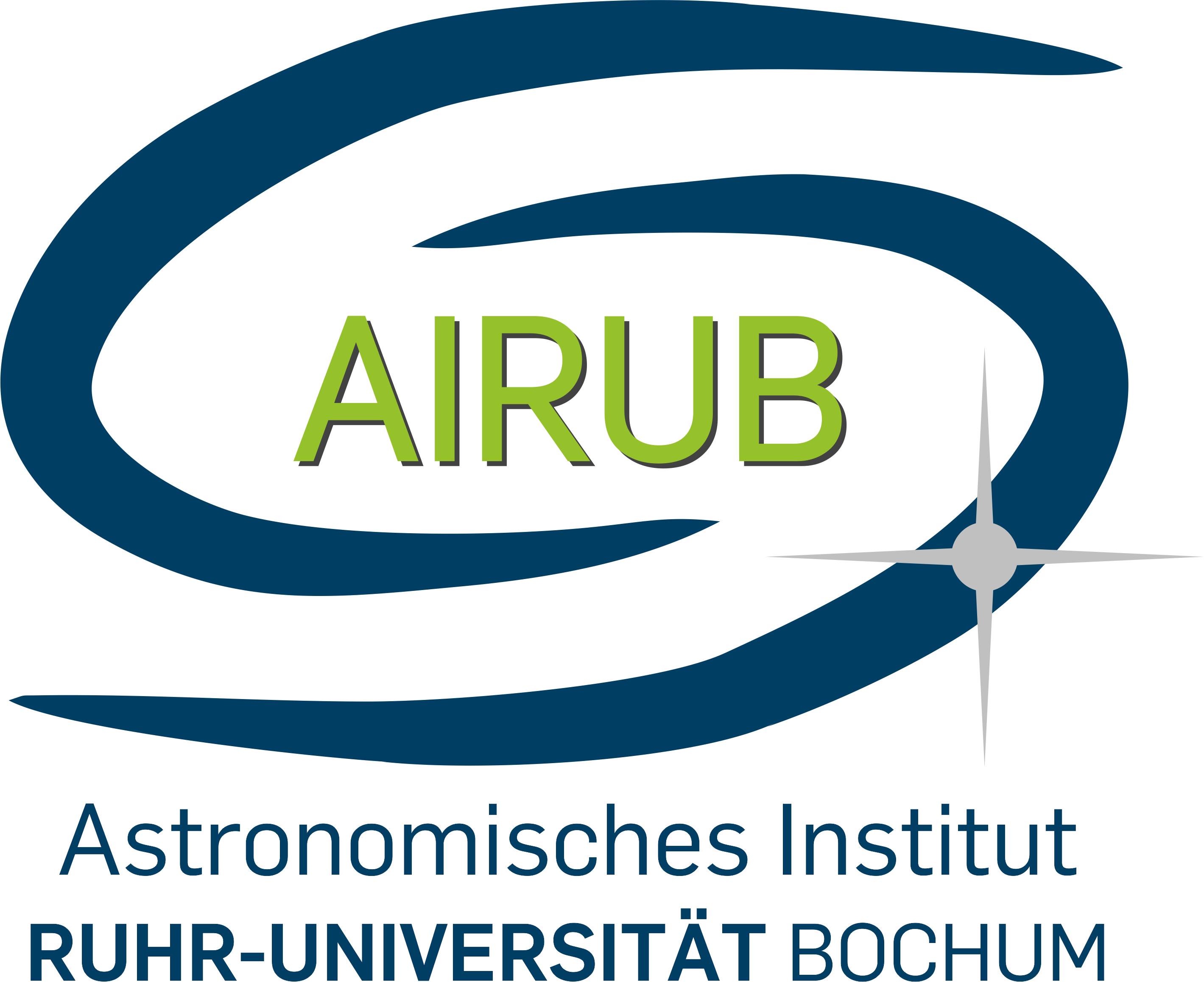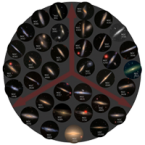News
13.05.2016 - Images of the Mercury Transit on the 9th of May
During the public observation of the Mercury transit on the 9th of May, several pictures of this event were taken at the Astronomical Institute of the Ruhr-University Bochum. A group of sunspots were visible in the center and in the upper third of the picture while the Mercury transit can be seen in the lower thirtd. When the sky was clear, Mercury appeared as a round, deep black disk. In this collage however, it is visible in different grayish colors due to clouds passing in front of the sun.
This collage consists of 35 single pictures, taken between 12:16 and 18:46 p.m. with one picture being taken about every 8 minutes. The equipment used for this was a Nikon D3300 camera and a Tamron 600 mm objective on an EQ5-Mounting.
29.04.2016 - Mercury Transit on the 9th of May
On the 9th of May, the planet Mercury will transit between the Earth and the Sun, an event known as Mercury transit. Starting at around 1:15 pm, the Mercury disk with a size of 12 arcseconds will enter the disk of the Sun and leave it again at around 8:40 pm. As with all solar observations, the sun should under no circumstances be observed without proper protection! Additionally, as the Mercury disk only covers 1/160 of the solar disk, it is too small to be be observed by the unaided eye. The astronomy group of the astronomical institute will therefore offer the possibility to view the Mercury transit between 2 pm and 6 pm through several telescopes on the roof of the building NA. If you are interested, please sign up with an email to merkur2016@astro.rub.de.
12.04.2016 - Meeting of the German Astronomical Society
This year's annual conference of the German Astronomical Society will take place at the Ruhr-Universität Bochum from the 12th to the 16th of September 2016.
The conference will feature talks about cutting-edge research in astronomy and additionally oportunities for networking and taking part in some of the additional events taking place around the conference, such as the "Young Astronomers Meeting" and workshops and training about topics such as public outreach and the history of astronomy. The website of the conference, http://www.ag2016.de, features additional information and a more detailed program. You can also see a small preview of the conference poster in the right sidebar.
Note for Students: The German Astronomical Society offers travel grants for students, including PhD students with no more than a 50% position, that includes partial or full refunds on traveling expenses and the conference fee. You can find more information here.
05.04.2016 - AIRUB on Facebook and Twitter
The AIRUB can now be found on facebook and Twitter. We will regularly post interesting and fascinating news about the AIRUB and astronomy in general there. Simply click the links in the text or the buttons on the lower left to get to the facebook and Twitter pages and follow the AIRUB!
05.03.2016 - Magellanic Clouds and the Milky Way
During his recent stay in Sutherland, South Africa, Prof. Dr. Ralf-Jürgen Dettmar managed to snap a couple of great pictures of the Large and Small Magellanic Clouds as well as the Milky Way with a simple camera setup.
The first of the two pictures below shows the Large Magellanic Cloud at the top and the Small Magellanic Cloud at the center of the picture. The second picture shows a part of the band of the Milky Way as you might also see it from Germany during the night in very dark places.
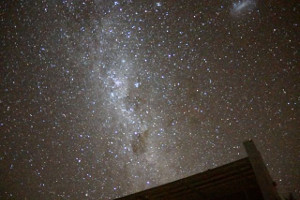 Pictures: © Ralf-Jürgen Dettmar
Pictures: © Ralf-Jürgen Dettmar
13.10.2015 - Galaxies with Radio Halos
In the CHANG-ES ("Continuum Halos in Nearby Galaxies, an EVLA Survey") project, astronomers are trying to understand the origin and evolution of radio halos around galaxies. The project is a cooperation between the AIRUB, the Max-Planck Institutes for Radioastronomy and Extraterrestrial Physics and additional institutes from different continents. In a recent study the researchers determined that these radio halos are significantly more frequent than previously thought. This was a result from images taken with the Karl G. Jansky Very Large Array (JVLA) in New Mexico, USA, that were analyzed with state-of-the-art image analysis techniques.
The full press releases can be found under the following links:
Press release of the RUB (German)
Press release of the NRAO (English)
28.09.2015 - Total Lunar Eclipse over Europe
A total lunar eclipse was visible over Europe in the early morning hours of September 28th. The Moon passed the central part of Earth's shadow between 4:12 and 5:24, so totality took place for about 1 hour and 12 minutes. Due to light scattering in Earth's atmosphere, the Moon appears red in the sky during this time. The Moon appeared especially large throughout this lunar eclipse, as the Moon passed its orbits closest point to Earth during the eclipse.
Anika Beer managed to take some great pictures of the different phases of this lunar eclipse that are put together to a collage below.
11.06.2015 - Observation Session: Sun and Planets
On the 10th and 11th of June, students from the lectures "Introduction to Astrophysics" and "Leben im All" had the opportunity to observe the sun as well as a few planets (Venus, Jupiter, Saturn) through the AIRUB's solar telescope and training telescope.
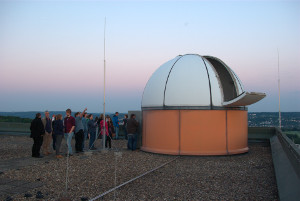
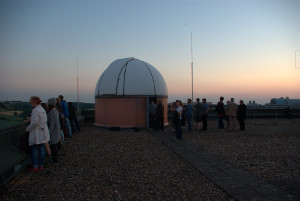 Pictures: © Dominik Bomans.
Pictures: © Dominik Bomans.
Click the images for a larger view.
About 30 students gathered on the roof of NA on the night of the 11th of June to catch a view through our telescope during excellent weather conditions.
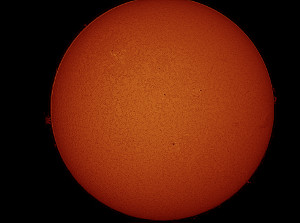
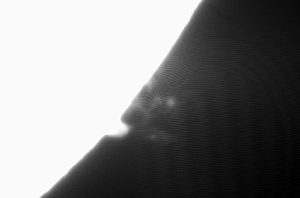 Pictures: © Anika Beer & Arpad Miskolczi.
Pictures: © Anika Beer & Arpad Miskolczi.
Click the images for a larger view.
Some observations of the sun were already carried out on the previous day, using the new Coronado solar telescope of the AIRUB. During this session, Anika Beer and Arpad Miskolczi managed to capture some amazing views of our sun (pictured above). The first image shows a full view of the sun, where you can see some sunspots and a few prominences around the sides. The second image is an animated gif that shows the movement of such a prominence over the course of about two hours. All images were captured at the H-Alpha wavelength with an Etalon being used as the filter
20.03.2015 - Fog Prevents View of Solar Eclipse
Unfortunately, foggy weather prevented our observations of today's solar eclipse, which was the last major eclipse that is visible from Germany until 2081.
Despite the bad weather, many people were interested in our observation facilities, as you can see on the picture above. We thank all participants, and look forward to future visitors on public observation nights, where once again stars and planets will be observed.
19.03.2015 - Solar Eclipse on March 20th, 2015
On the occasion of the partial solar eclipse with 78% occultation, the Astronomical Institute will offer the opportunity to observe it on the southern part of the roof of the building NA. There, we will aim our 40 cm telescope, as well as a number of smaller telescopes, towards the sun to observe the eclipse.
The eclipse starts at around 09:30, has its maximum occultation at 10:38 and ends around 11:50. Visitors are very welcome, we would just ask you to please send a short E-mail to muenstermann@astro.rub.de if you plan to visit.
12.02.2015 - Jupiter & New Parts for the Training Telescope
During the testing of some new parts for the training telescope of the AIRUB, Arpad Miskolczi managed to take this pictures of Jupiter during good seeing. Jupiter's striking Great Red Spot is clearly visible in the image - a storm active for hundreds of years.
17.08.2014 - Noctilucent Clouds over the RUB
Sebastian Schulze managed to capture some great pictures of noctilucent clouds over Bochum during an observation session on the roof of NA, that took place as part of the "Leben im All" lecture on the 3rd of July. Click below for larger versions of these images.




